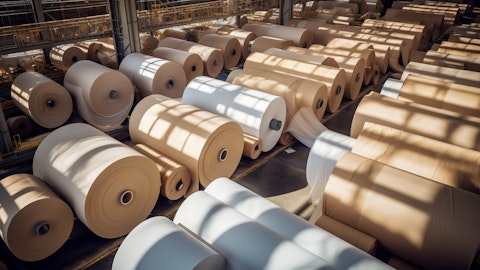Jean-Michel Ribiéras: Yeah. So 2023, as you know, in Europe was difficult. It was a trough in terms of demand. The prices of pulp, which affect a lot our Saillat mill went down. We had an annual outage in Saillat, which costed us $20 million. We had an annual outage in the fourth quarter in Nymolla. We had an issue with the turbine we mentioned in the Saillat mill, which is over now, which costed us $5 million and it was really the trough of the cycle in terms of prices. So we clearly see 2024 rebounding significantly and hope to very soon be talking about positive earnings for Europe. So we are quite positive about Europe. It’s more cyclical than any other businesses. So sometimes it’s a bit frustrating, but on average, we really believe Europe would be good, Nymolla is performing very well, Saillat is performing well, order book, as I mentioned, is good and we have seen price increasing. So Europe is rebounding significantly. It’s tailwind for 2024.
George Staphos: Thank you.
John Sims: Yeah. George, just to add on to that…
George Staphos: Go ahead, John
John Sims: We say that it was a trough, but it was a significant. You think about in terms of demand decline that we had in Europe, it was even worse than COVID. When you look at how much volume and shipments were down and also pulp prices, Saillat is, one-third of its capacity is pulp. So it is to certain extent more exposed to the cyclical pulp prices than our other mills. But as Jean-Michel said and we said earlier, we are currently running full right now in Europe and so that’s a very positive. We also have prices going up both in paper and pulp. So the reason — thing that’s helped us with pulp prices going up already almost $160 per ton versus trough would indicate that Europe would be better.
George Staphos: Thank you, John.
Operator: Next we will go back to the line of Harman Dhatt from RBC. Please go ahead.
Harman Dhatt: Hi. Thanks. I just had a couple quick follow-ups on the cost reduction plan and apologies if it was mentioned earlier, had some technical difficulties at the start of the Q&A. But just had a quick clarifier, that $15 million reduction in overhead expenses, is that factored into your $110 million target or is this on top of it? And I suppose secondly, will there be an update to the prior inflation assumption, I believe it was around $50 million with Q3 results?
John Sims: Yeah, Harman. The $50 million that we reported for the fourth quarter is additive or was not included in the $110 million target that we talked about, when we reported the third quarter. And the inflation number that we provided, you are correct, was $50 million and that won’t be updated. That’s still a good number.
Harman Dhatt: Got it. Yeah. That’s all from my end. Thank you.
Operator: And next we will go back to the line of George Staphos. Please go ahead.
George Staphos: Hi, guys. Last one for me. Now you are not the only company in South America that’s talked about having to go farther from its own mills for wood and do a bit more third-party wood and although the company, in particular, I am thinking of is more packaging grade production. But is there a broader issue that’s been affecting the producers, has it been just the droughts or has there been something else that’s gone on, either in terms of maybe over harvesting or underinvesting that, not just for Sylvamo, you have seen elsewhere, just some quick thoughts there and I will turn it over.
Jean-Michel Ribiéras: I think you — some of our competitors talked about the same thing we did on some plantations about six years to seven years ago, where those plantations have suffered under the seven-year cycle of drought, natural causes, which have impacted and that has impacted all Brazilian forestry plantations. So we are not the only one. This is not the case anymore. But it’s been two years. And we also, specifically, more significantly from our past companies, reduced some of our investments in the forestry during those years, which we are — it’s a six-year, seven-year cycle. So we are seeing the impact of that now, which is why we have had to go more outside market than we usually do and we wanted to solidify the need of wood, because there is a strong demand of wood in Brazil right now.
So the demand is clearly strong. So the demand plus the natural causes which have reduced the productivity of plantation is an impact we are feeling and our strategic investment in the very valuable forestlands we have will make up for that.
George Staphos: I mean, we are starting to see a little bit of an uptick in South America overall in box shipments, obviously, that’s a bit more soft wood. But to the extent that we see a bit of a rebound there, does that put your wood position and maybe make it a bit more precarious and mean that next quarter or quarter down the road you are talking about further inflation that you are contending with or are you, as much as you can, relatively well set for the rest of the year?
Jean-Michel Ribiéras: With the investment we have made we feel like we are well set.
George Staphos: Okay. Thank you, Jean-Michel. Good luck in the quarter. Thank you, John.
Jean-Michel Ribiéras: Thank you.
Operator: And at this time, there are no further questions. I’d now like to turn the call back to Hans Bjorkman for any closing comments.
Hans Bjorkman: Thanks, Greg. Before we wrap up the call, Jean-Michel, any closing comments?



